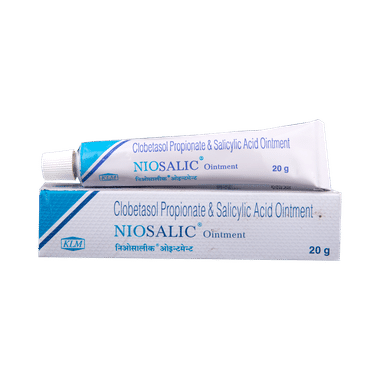

Clobetasol (0.05% w/w)+ Salicylic Acid (3% w/w)
Niosalic Ointment should be used in the dose and duration as advised by your doctor. Wash your hands before using this medicine. It is advised to check the label for directions before use. It is for external use only.Do not use this medicine more than the recommended dose. Inform your doctor if you have known allergies to this medicine. The common side effects of this medicine include peeling of the skin, thinning of the skin, burning, itching, irritation, and redness at the application site.If these side effects or any other symptoms which you think are because of this medicine persist for a longer duration, please consult your doctor. Inform your doctor if you are pregnant or are suffering from any other disease. This medicine is safe to use in breastfeeding mothers.
Most side effects do not require any medical attention and disappear as your body adjusts to the medicine. Consult your doctor if they persist or if you’re worried about themCommon side effects of Niosalic
20 gm Ointment
Image shown is a representation and may slightly vary from the actual product. Every effort is made to maintain accuracy of all information displayed.
This medicine is for external use only. Use it in the dose and duration as advised by your doctor. Check the label for directions before use. Clean and dry the affected area and gently massage the ointment.
Niosalic Ointment is a combination of two medicines: Clobetasol and Salicylic Acid, which treats eczema and psoriasis. Clobetasol is a steroid which blocks the production of certain chemical messengers (prostaglandins) that make the skin red, swollen and itchy. Salicylic Acid is a keratolytic medicine which breaks down keratin clumps, removes dead skin cells and softens the skin. It also enhances the absorption of Clobetasol into the skin.
Related Warnings
No interaction found/established
Niosalic Ointment may be unsafe to use during pregnancy. Although there are limited studies in humans, animal studies have shown harmful effects on the developing baby. Your doctor will weigh the benefits and any potential risks before prescribing it to you. Please consult your doctor.
Niosalic Ointment is probably safe to use during breastfeeding. Limited human data suggests that the drug does not represent any significant risk to the baby.
No interaction found/established
No interaction found/established
No interaction found/established
Follow the directions given by the doctor or provided on the medicine. Apply the medicine thinly and in sufficient quantity to cover the affected areas. Niosalic Ointment is usually applied two or three times a day to the affected areas of skin. Wash your hands after using Niosalic Ointment, unless it is used for treating skin infection on the hands.
No, do not stop using Niosalic Ointment and complete the full course of treatment, even if you feel better. Your symptoms may improve before the disease is completely treated.
Niosalic Ointment should not be used on the face. Do not use the medication for longer than the advised periods of time. Do not apply a bandage or dressing to the area being treated, as this will increase absorption of the preparation and increase the risk of side effects. This medicine should only be used by the patient and never give it to other people, even if their condition appears to be the same.
No, Niosalic Ointment will not be more effective if overused. Overusing the medicine can result in too much medicine being absorbed into the body. This may lead to thinning or weakening of the skin and other serious side effects. If you are experiencing increased severity of your symptoms, please consult your doctor for re-evaluation.
Keep this medicine in the container or the pack it came in, tightly closed. Store it according to the instructions mentioned on the pack or label. Dispose of the unused medicine. Make sure it is not consumed by pets, children and other people.